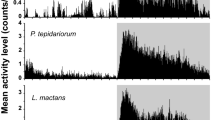Summary
-
1.
The locomotor activity of European salamanders differs from species to species. At all stages of development Triturus vulgaris is more light-active, Salamandra salamandra is dark-active, while Triturus alpestris and cristatus occupy an intermediate position.
-
2.
The activity of the larvae is high but the rhythm is not very pronounced. Triturus larvae are less dark-active than adults (Fig. 2).
-
3.
Periodism disappears completely during metamorphosis but after some weeks of terrestrial life a diurnal rhythm reappears (Fig. 3).
-
4.
Adults of Triturus species show an increased activity during their aquatic life in spring: they are active by day and night, maxima occurring in twilight or darkness.
-
5.
Terrestrial adults leave their hiding places only during twilight or darkness. Triturus vulgaris and alpestris display locomotor activity in twilight only whereas Triturus cristatus and Salamandra salamandra are also active in the dark (Figs. 5, 6).
Zusammenfassung
-
1.
Registrierungen der Bewegungsaktivität bei mitteleuropäischen Salamandriden ergaben artliche Unterschiede. In allen Entwicklungsstadient ist Triturus vulgaris am stärksten lichtaktiv, Salamandra salamandra am meisten dunkelaktiv, während Triturus alpestris und cristatus eine Zwischenstellung einnehmen.
-
2.
Bei den Larven ist die Aktivität hoch, eine Rhythmik aber nur schwach ausgebildet. Triturus-Larven sind weniger dunkelaktiv als die adulten Tiere.
-
3.
Während der Metamorphose verliert sich die Periodizität vollständig. Sie bildet sich erst nach mehreren Wochen des Landlebens wieder aus.
-
4.
Adulte Molche während des Wasseraufenthaltes im Frühjahr sind in den Licht- und Dunkelzeiten aktiv. Die Maxima liegen in der Dämmerung bzw. Dunkelheit. Aktivitätsmenge sowie das Verhältnis von Aktivitäts- zu Ruhezeiten sind höher als bei den Landmolchen.
-
5.
Adulte Landtiere verlassen ihre Verstecke nur während der Dämmerungs- und Dunkelzeiten. Die Bewegungsaktivität beschränkt sich bei Triturus vulgaris und alpestris auf die Dämmerung, bei Triturus cristatus und Salamandra salamandra tritt sie auch während der Dunkelheit auf.
Similar content being viewed by others
Literatur
Adler, K.: Extraoptic phase shifting of circadian locomotor rhythm in salamanders. Science 164, 1290–1292 (1969).
Aschoff, J.: Aktivitätsmuster der Tagesperiodik. Naturwissenschaften 44, 361–367 (1957).
—: Spontane lokomotorische Aktivität. In: Handbuch der Zoologie, Bd. 8, Teil 11/4, S. 1–74. Berlin: W. de Gruyter & Co. 1962.
—: Die Tagesperiodik licht- und dunkelaktiver Tiere. Rev. suisse Zool. 71, 528–558 (1964).
— Wever, R.: Aktivitätsmenge und α:ϱ-Verhältnis als Meßgrößen der Tagesperiodik. Z. vergl. Physiol. 46, 88–101 (1962).
Bennet, M.F., Stanley, J.: Cycles of motor activity in the newt Triturus viridescens. Anat. Rec. 137, 339 (1960).
Gasche, P.: Beitrag zur Kenntnis der Entwicklung von Salamandra salamandra (L.) mit besonderer Berücksichtigung der Winterphase, der Metamorphose und des Verhaltens der Schilddrüse (Glandula thyreoidea). Rev. suisse Zool. 46, 403–548 (1939).
Glaesner, L.: Normentafel zur Entwicklung des gemeinen Wassermolches (Molge vulgaris). In: Keibel, Normentafeln zur Entwicklungsgeschichte der Wirbeltiere, Heft 14. Jena: Fischer 1925.
Himstedt, W.: Beobachtungen zum Paarungsverhalten des Feuersalamanders (Salamandra salamandra L.). Zool. Anz. 175, 295–300 (1965).
—: Experimentelle Analyse der optischen Sinnesleistungen im Beutefangverhalten der einheimischen Urodelen. Zool. Jb. Abt. allg. Zool. u. Physiol. 73, 281–320 (1967).
Joly, J.: Données sur l'écologie de la Salamandre tachetée Salamandra salamandra taeniata Düringen (1897). Bull. Soc. zool. France 84, 208–215 (1959).
—: Données écologiques sur la Salamandre tachetée Salamandra salamandra (L.). Ann. Sci. Nat., Zoologie, 12. Sér., 10, 301–366 (1968).
Kalmus, H.: Diurnal rhythmus in the Axolotl larva and in Drosophila. Nature (Lond.) 145, 72–73 (1940).
Machan, R., Himstedt, W.: Ein neuer kapazitiv arbeitender Aktograph. Oecologia (Berl.) 4, 211–217 (1970).
Matthes, E.: Die Rolle des Gesichts-, Geruchs- und Erschütterungssinnes für den Nahrungserwerb von Triton. Biol. Zbl. 44, 72–87 (1924).
Möller, A.: Die Struktur des Auges bei Urodelen verschiedener Körpergröße. Zool. Jb. Abt. allg. Zool. u. Physiol. 62, 138–182 (1951).
Müller, K.: Die Tagesperiodik von Fließwasserorganismen. Z. Morph. Ökol. Tiere 56, 93–142 (1966).
—: Jahreszeitliche Wechsel der 24 h-Periodik bei der Bachforelle (Salmo trutta L.) am Polarkreis. Oikos 20, 166–170 (1969a).
—: Die Tagesperiodik bei Fischen. Öster. Fischerei 22, 6–9 (1969b).
Ralph, C.L.: A diurnal activity rhythm in Plethodon cinereus and its modification by an influence having a lunar frequency. Biol. Bull. 113, 188–197 (1957).
Siegmund, R.: Lokomotorische Aktivität und Ruheverhalten bei einheimischen Süßwasserfischen (Pisces; Percidae, Cyprinidae). Biol. Zbl. 88, 295–312 (1969).
Smith, J.J.B.: Hearing in terrestrial Urodeles: a vibration—sensitive mechanism in the ear. J. exp. Biol. 48, 191–205 (1968).
Swift, D.R.: Activity cycles in the brown trout (Salmo trutta L.). Hydrobiologia 20, 241–247 (1962).
—: Activity cycles in the brown trout (Salmo trutta L.). II. Fish feeding naturally. J. Fisheries Res. Board Canada 21, 133–138 (1964).
Szabò, I.: Nahrungswahl und Nahrung des gefleckten Feuersalamanders (Salamandra salamandra L.). Acta zool. Acad. Sci. hung. 8, 459–577 (1962).
Wündsch, L., Himstedt, W., Bornschein, H.: E- und I-Netzhäute von Urodelen. Experientia (Basel) 24, 731–733 (1968).
Author information
Authors and Affiliations
Additional information
Mit Unterstütszung des Fonds zur Förderung der wissenschaftlichen Forschung.
Rights and permissions
About this article
Cite this article
Himstedt, W. Die Tagesperiodik von Salamandriden. Oecologia 8, 194–208 (1971). https://doi.org/10.1007/BF00345813
Received:
Issue Date:
DOI: https://doi.org/10.1007/BF00345813




